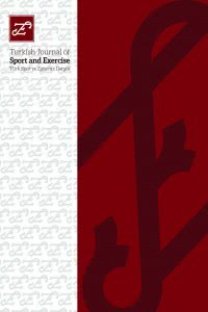Relative strength, body mass and height as predictors of olympic weightlifting payers performance
___
1.Abdel-fattah, AB.: Sports training Physiology references in physical education and fitness 3, El-fekr Alaraby library, Cairo, 2003.2. Al-desoky, M.: the contribution percentages in level number for muscles power output of categories of performances for both snatch and clean and jerk lifts for weightlifting players. Master search physical Education of sport, mansora university, 2006.
3. Christian, H.: Objektive Ueberpruefung des kalkulationsmusters der motion power console 500 von der firma emotion fitness zur Ermittlung des startgwichtes beim apparativen krafttraining sowie die Angabe weiterfuehrenden Empfehlungen. Diplomarbeit, kluesserath, Germany, 2007.
4. Ebada, KH.: Growth equation as a mark to the Prediction of Olympic Players results of Weightlifting Sport. The first scientific conference "sport University in Arab countries from 6-7 Feb 2006. Physical Education of sport - Mansoura University, 2006.
5. Ebada, KH.: Die Probleme des Trainings von Gewichthebern kindes- und Jugendalter. Dissertation, Germany, 2003, 60-63.
6. Ford, E., Alvin, J. Detterline, K. ; wenyuan, C.: Gender- and height-related limits of muscle strength in world weightlifting champions. J Appl Physiol, 2000, 89: 1061–1064.
7. Haleczko, A.: Indices of the Relative Strength Fitness of the Disabled Weightlifters. Kinesiology, 2001,11(22): 21-25. ICID: 471754.
8. Hare, D.: Principles of Sports Training Introduction to the Theory and Method of Training”, Berlin, 1992.
9. Hollmann, W. and Hettinger, T.: Sportmedizin. 4auflage schattauer verlagsgesellschaft mb Hstuttgart, Germany, 2000.
10. Kanyevsky,V.: The Dependence Between the Weightlifter's Absolute and Relative Strength on Weight Class. Translated by Andrew Charniga, Jr. The Russian weightlifting library. Sportivny, Press. Russian. http://www.dynamiceleiko.com /sportivny/ library/ news/nv006.html, 2003.
11. Kauhanen, H.; Komi, P.; Häkkinen, K.: Standardization and validation of the body weight adjustment regression equations in Olympic weightlifting. J. Strength Cond. Res. 2002, 16(1):58–74.
12. Mochernyuk, V, Draga V. Determining the Dependence between Weightlifting Results in Different Weight Classes. Translated by Andrew Charniga, Jr. The Russian weightlifting library. Sportivny, Press. Russian. http://www. dynamiceleiko. com/sportivny/library /farti cles 001. html, 2001.
13. Stone, M.; Sands, W.; Pierce, K.; Carlock, J.; Cardinale, M.; Newton, R.: Relationship of Maximum Strength to Weightlifting Performance. Medicine & Science in Sports & Exercise. 2005, 37(6):1037-1043.
14. Thé, D. J.; Lori, P.: Age, Body Mass, and Gender as Predictors of Masters Olympic Weightlifting Performance. Med. Sci. Sports Exercise, 2003, 35(7):1216-1224.
15. Wutscherk, H.: Grundlagen der Sportanthropometrie. Leipzig, 1985.
16. www.IWF.net10/11/2009 PM12:00.
17. www.weightliftingmen\results11/05/2009 PM.10.00.
18. Zatsiorsky, M.: Krafttraining. Praxis und Wissenschaft. Aachen, 2000.
- ISSN: 1300-9915
- Yayın Aralığı: Yıllık
- Başlangıç: 2018
- Yayıncı: -
Pilates’in durum analizi: Eskişehir il örneği
DENİZ ŞİMŞEK, KEREM YILDIRIM ŞİMŞEK
Performance analysis and its didactic applicability in the motor-sports and educational field
Stefania CARROZZA, Giuseppe BALDASSARRE, Rodolfo VASTOLA, Filipo PALOMA GOMEZ
Basketbolcuların oyun pozisyonlarına göre reaksiyon zamanlarının karşılaştırılması
Düzenli egzersize katılımın egzersiz bağımlılığı üzerine etkisi
ÖZHAN BAVLI, M. Erkan KOZANOĞLU, AHMET DOĞANAY
New technologies for motor didactics
Nadia CARLOMAGNO, Stefano TORE DI, Rosa SGAMBELLURİ, Veronica FRAGNITO, Filippo PALOMA GOMEZ
AYŞEGÜL ŞÜKRAN ÖZ, HÜSEYİN KIRIMOĞLU, Ali TEMİZ
Submaksimal efor sırasında farklı tip müziğin bazı fizyolojik parametreler üzerine etkisi
Haluk KOÇ, Turchian CURTSEİT, HÜDAVERDİ MAMAK
Hakan Salim ÇAĞLAYAN, Mehmet Çağrı ÇETİN, YUNUS YILDIRIM, Özer YILDIZ
